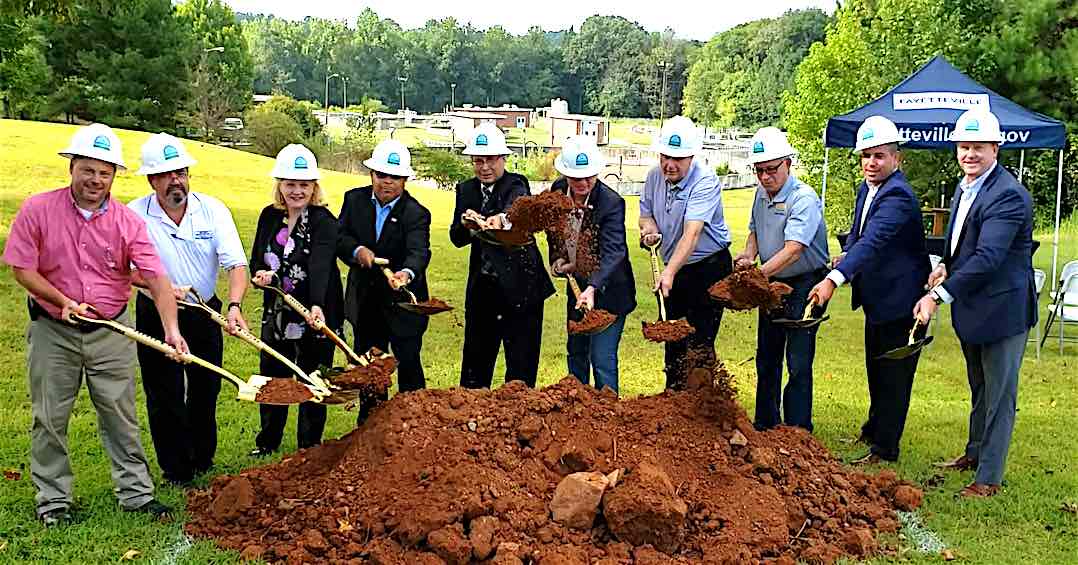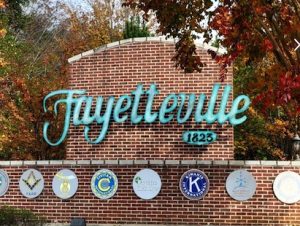Fayetteville officials and project team members on Aug. 28 ceremonially broke ground at the Whitewater Creek Water Pollution Control Plant in anticipation of a facility upgrade slated to begin this fall and be completed in late 2020 or early 2021.
“Currently, the city’s plant operates using two distinct processes,” said city Public Relations Specialist Danny Harrison. “One portion of the plant utilizes a sequence batch reactor treatment process, and the other portion of the plant utilizes an activated sludge process. Together, both processes provide a treatment capacity of five million gallons per day at the plant. The upgraded plant will consolidate the two processes into one, using what is known as an oxidation ditch, which is more energy efficient and sustainable into the future. It will continue to provide five million gallons per day in treatment capacity, in a much more efficient and easy to operate fashion.”
Architectural and engineering firm Goodwyn, Mills & Cawood was selected to design the upgraded facilities, and construction company Reeves Young was selected to build it.
“We at GMC were very excited to be selected to work on this project, and have greatly enjoyed working with Fayetteville staff to develop a design that will not only allow the City to treat wastewater in a more efficient way, but also allow the plant to easily treat additional waste as the city continues to grow,” said Andy Pippin with Goodwyn, Mills and Cawood.
“We know that choosing to invest funds into something that most citizens will never see is a hard decision,” Pippin continued. “We commend the leadership of the Mayor and Council, and the direction by staff, to do just that. Fayetteville will be in great shape to welcome new economic development opportunities while keeping the environment around the plant clean and healthy.”
Also commenting on the project Fayetteville Public Services Director Chris Hindman said, “We have been looking forward to this upgrade for a while, as it will ensure the City of Fayetteville maintains its water treatment quality standards well into the future. Currently, we average around 2.3 million gallons of wastewater treated daily. As Fayetteville grows, maintaining that additional capacity will help us address those future needs.”
Hindman says the construction process is being planned in a way that there will be uninterrupted wastewater treatment throughout.
The Whitewater Creek Water Pollution Control Plant was originally designed by Miller, Stevenson and Steinchen, Inc. in 1977 and constructed in 1978-1979. The treatment process utilized a contact stabilization (CS) activated sludge process, with second stage nitrification with a treatment capacity of 1.25 MGD. In order to meet anticipated growth demands of the Community, the facility was expanded in 1992 to include a sequencing batch reactor process (SBR). The SBR plant was designed by Stevenson and Palmer Engineering, Inc., having a treatment capacity of 2.5 MGD and provided the City with a combined treatment capacity of 3.75 MGD with in conjunction with the CS plant.
With wastewater flow into the facility being less than half of the permitted capacity, the City removed the CS plant from service to save operational and maintenance costs. At that time, the CS plant was left inoperable but intact, with the SBR plant treating all of the wastewater flow. In 2004, the facility was operating at flows between 2.0 and 2.5 MGD with peak flows in excess of 5.0 MGD during heavy rain events. These conditions led the City to reevaluate their wastewater treatment capacity and expand the facility again in 2007. This expansion consisted of converting the original CS plant to a Conventional Activated Sludge (CAS) plant and continued operation of the SBR plant. The CAS plant was designed for a treatment capacity of 2.5 MGD giving the City a total treatment capacity of 5.0 MGD when operated in parallel with the SBR plant.













Leave a Comment
You must be logged in to post a comment.